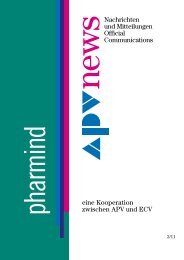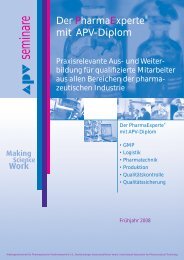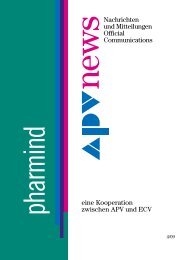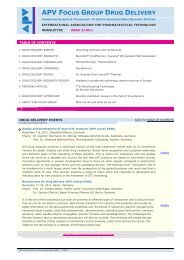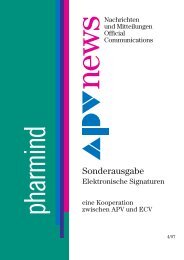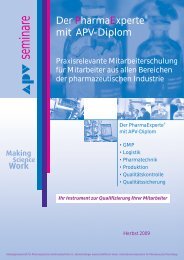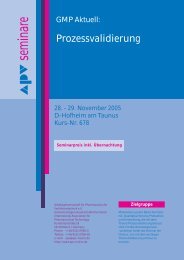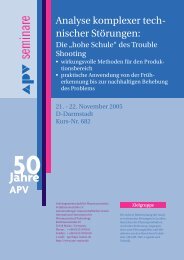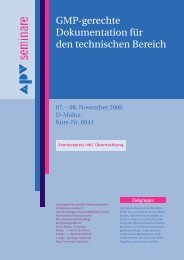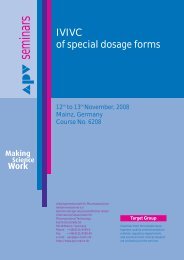APV FOCUS GROUP DRUG DELIVERY
APV FOCUS GROUP DRUG DELIVERY
APV FOCUS GROUP DRUG DELIVERY
You also want an ePaper? Increase the reach of your titles
YUMPU automatically turns print PDFs into web optimized ePapers that Google loves.
Parma<br />
Institution Italy, Parma: Università degli studi die Parma<br />
Group Dipartimento Farmaceutico<br />
Key contact Prof. ssa Patrizia Santi<br />
Website http://www.unipr.it/arpa/dipfarm/<br />
E-Mail patrizia.santi@unipr.it<br />
Research areas • Mechanisms involved in iontophoretic drug transport (passive diffusion, electrotransport<br />
and electroosmosis),<br />
• Iontophoretic delivery of peptides and proteins,<br />
• Reverse iontophoresis for diagnostic purposes and<br />
• Realization of innovative transdermal drug delivery systems.<br />
Disclaimer: Although every effort has been made to check the accuracy of the contents of the tables, including contacting<br />
the groups involved, there may be some inaccuracies and/or omissions.<br />
FEATURED ARTICLE BACK TO TABLE OF CONTENTS<br />
THE ÉLAN OF <strong>DELIVERY</strong> TECHNOLOGY DEVELOPMENT<br />
By Louise Rosenmayr-Templeton, Ph.D., Tower Pharma Consulting, Auhofstrasse 197/10, A-1130 Vienna<br />
1. Introduction<br />
On 9 May 2011 it was announced that Alkermes Inc. (Waltham, MA, USA) and the Elan Corporation plc (Dublin, Ireland)<br />
had signed an agreement under which Alkermes would merge with Elan Drug Technologies (EDT), the drug delivery<br />
division of the Elan Corporation [1]. The cash and stock transaction is valued at US $960 with Elan receiving US $500<br />
million cash plus an around 25 % stake in the new company to be named Alkermes plc and headquartered in Ireland.<br />
The deal, which at the time of writing this article, was still subject to the approval of Alkermes shareholders, regulatory<br />
go-ahead and customary closing conditions, creates a company with over 25 commercialised products and a pipeline of<br />
proprietary and partnered products. The focus will be on products for the treatment of diseases of the Central Nervous<br />
System which fits with the portfolios of both parties to the merger.<br />
Although the Elan Corporation’s 25 % stake in Alkermes plc means that it has not completely divorced itself from the<br />
world of drug delivery, it is to an extent the end of an era. That era began in Ireland in 1969 when the American entrepreneur,<br />
Donald Panoz, founded the company, which was then solely focused on improving the oral delivery of established<br />
drugs through the development of novel formulation technologies<br />
This short review article looks back at the company’s contribution to therapeutic delivery in terms of technologies<br />
currently used in commercialized or late stage clinical products. It includes some technologies that are no longer part of<br />
the Elan portfolio but were spun-out or sold to other companies. In the interest of brevity I have deliberately excluded<br />
technologies which were owned by the company for a short time. These include those developed by the former Quadrant<br />
Healthcare (through the acquisition of Innovata plc now part of the Ventura Group [2, 3]) and The Liposome<br />
Company whose Abelcet® product is now sold by Sigma Tau Pharmaceuticals Inc. [4]. The article also looks briefly at<br />
some of the start-up companies that came into being following Elan’s financial difficulties in 2002/2003.<br />
2. Technologies Currently within the Elan Drug Technologies Portfolio<br />
2.1 NanoCrystal ® Technology<br />
NanoCrystal ® technology, is Elan’s particle size reduction technology to increase the solubility of poorly-soluble drugs<br />
[5-7]. This technology did not originate within Elan itself, but was initially developed by NanoSystems LLC, a subsidiary<br />
of Eastman Kodak [8]. It employed Eastman’s expertise in milling pigments to develop a wet milling and particle stabilization<br />
technology to reduce the size of drug particles to less than 2000 nm and maintain their physical stability over<br />
time. Stabilisation against agglomeration is achieved by absorbing selected GRAS (Generally Regarded As Safe) stabilizers<br />
to the surface of the particles. The resulting solution can be further processed and incorporated into a variety of<br />
dosage forms.<br />
It was in the late 1990s that it became apparent that this technology showed great promise in improving the bioavailability<br />
of drugs whose solubility was dissolution-rate limited. In September 1998 Elan bought NanoSystems from Eastman<br />
Kodak for US $150 million [8]. The NanoCrystal technology is Elan’s most successful delivery technology and is the<br />
basis of 5 marketed products which generated US $1.9 billion plus in annual in-market sales in 2010. These include<br />
Rapamune ® Tablets (Wyeth, now Pfizer), Megace ® ES Suspension (Strativa Pharmaceuticals), Emend ® Capsules (Merck)<br />
and Tricor ® 145 Tablets (Abbott Laboratories). Use of the technology has in some cases not only improved bioavailability,<br />
but also allowed dose reduction (Tricor ® 145) and/or removed or reduced the effect of food on drug absorption<br />
<strong>APV</strong> Drug Delivery Focus Group Newsletter – 2/2011 Page 8 of 15



